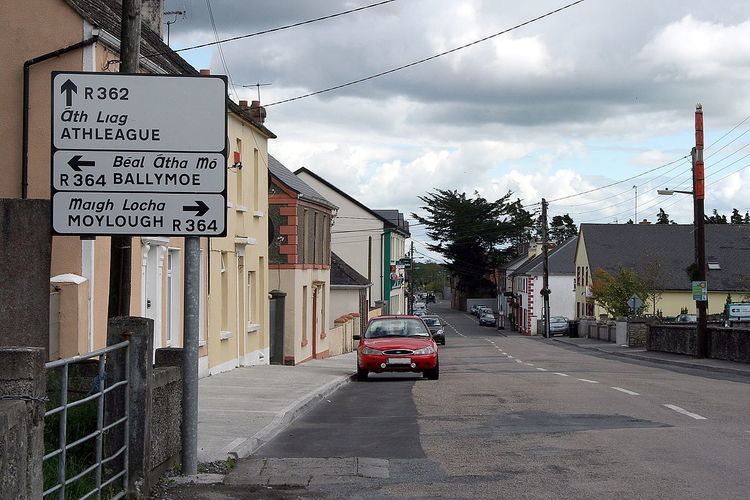Irish Grid Reference M627620 Population 516 (2006) | Elevation 87 m Local time Tuesday 7:08 PM | |
 | ||
Weather 9°C, Wind SW at 11 km/h, 77% Humidity | ||
Glenamaddy (Irish: Gleann na Madadh, meaning "valley of the dogs") is a small town in County Galway, Ireland. It lies at the crossroads where the R362 and R364 regional roads meet.
Contents
Map of Glenamaddy, Co. Galway, Ireland
Glenamaddy is the closest town to Roscommon in the northeastern corner of County Galway. It became the musical capital of Connacht during the 1960s when the Showband craze swept the country. To the east of the town lies Loch Lurgeen, a raised bog. The origins of the Parish (which was originally called Boyounagh) lie in the village of Boyounagh which lies to the North West of Glenamaddy Town.
Name
It has been argued for a long time what the exact meaning, and Irish for Glenamaddy is. Some say it is derived from the Irish Gleann na Madadh, Gleann meaning valley and madhadh from madra meaning dog. This would suggest that the name means Valley of the Dogs. The suggested meaning for this being the shape of the Glenamaddy Turlough as looked at from above.
The other explanation that has been given is that the name comes from Gleann na Maighe Duibhí meaning Valley of the black plain, because of the lake (Turlough) in the area which dries up every year leaving a black plain.
History
Glenamaddy was located in what was the medieval kingdom of Uí Díarmata, ruled by the O Concannon dynasty.
The town itself did not develop until the 1820s when a church was built and regular markets began in the town. From this time on the town began to grow and shops and pubs sprang up around the square and on the four roads leading into the town which are famous from the song of the same name. In 1853 a workhouse was built on the Creggs road.
In 1904 St. Patrick's church was built to replace the older church which was in the grounds of where the town graveyard stands today. In 1909 St. Bridget's Town Hall was built and played an important role in the social and cultural life of the parish. In 1924 a mill was built in Leitra, this gave badly needed employment to the area. Other places of interest include a megalithic tomb at Ballinastack, a crannóg on Kiltullagh lake and the Jeremiah Mee Memorial on the wall outside Phelan's lounge.
In the early 20th century markets were hugely popular in the town as for some small cottage industries it was the main outlet for their wares. Cattle, pigs, sheep, animal feeds, and household supplies were all sold at these markets and large crowds gathered in the town on these days. All goods being sold in the town were weighed at the weigh-house.
In recent years, Glenamaddy has seen significant decline after the loss of its Bank of Ireland and Ulster Bank branches, in 2006 and 2013, respectively. The town has lost over 120 of its young people to emigration and faces the possibility of further abandonment in the future.
Esker Mass Rock
A priest would travel to Esker from some unknown place and celebrate Mass at the site. Very often a screen or curtain divided the priest from the congregation, this was to protect the priest’s identity. During the time of the Penal Laws, around the 1790s a priest was celebrating Mass at Esker. An informer had notified the authorities that the priest would be there. Although scouts were positioned along the hilltops they didn’t see the Red Coats because they were dressed as common people and mingled among the crowd. As soon as the priest arrived he was captured and was given a mock trial. He was hanged from a tree which is now called Sceach na gCloigeann the white thorn tree of the heads. Along with the priest a number of people were massacred. The valley in which this occurred is known as Gleann an tSagairt, the priest’s valley. The rock on which sentence was delivered is called "Carraig an Bhreithiunais”. A bell was found in a nearby field some years later. A brass cross was also found with no base, which had been painted black to prevent reflection of sunlight. For the millennium, Mass was celebrated by Canon Michael Goaley P.P. and Fr. Tom Kearney C.C.
Culture
Glenamaddy boasts a long tradition of music and drama.
The Esker ballroom was once one of the most popular dance venues in the country. The Sound of Music opened by Jim "Pete" Keaveney, with opposition from the church. In 1947 the Esker Ballroom was built on the Kilkerrin Road in Glenamaddy, but because this was during the war and because of some objection he could not hold get a licence to hold dances or have a bar in the building. Eventually these problems were overcome and on the 27th of April 1949 the first dance was held in The Esker Ballroom. The dance was very successful and was the first of many, held every second Sunday, which would make the Esker Ballroom famous throughout the country. In 1970 the Esker Ballroom closed as marquees who were in direct competition with the Ballroom became more and more popular in the area. The building was sold to Joe O'Neill who then set up the Sound of Music night club which was also a huge success for many years and drew crowds from all over Connaught and indeed Ireland.
Community School
Glenamaddy Community school was founded in 2002 by the Sisters of Mercy and Co. Galway VEC following the amalgamation of Coláiste Seosaimh and St. Benin’s Vocational School.
